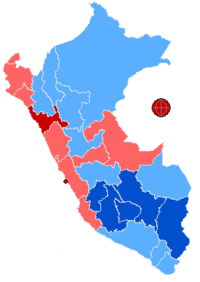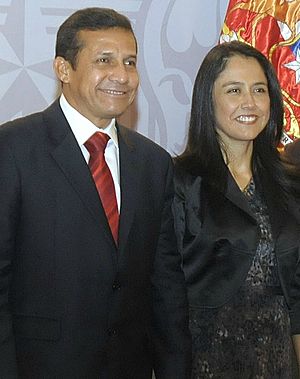Ollanta Humala facts for kids
Quick facts for kids
Ollanta Humala
|
|||||||||||||||||||||
|---|---|---|---|---|---|---|---|---|---|---|---|---|---|---|---|---|---|---|---|---|---|

Humala in 2016
|
|||||||||||||||||||||
| 58th President of Peru | |||||||||||||||||||||
| In office 28 July 2011 – 28 July 2016 |
|||||||||||||||||||||
| Prime Minister |
See list
Salomón Lerner Ghitis
Óscar Valdés Juan Jiménez Mayor César Villanueva René Cornejo Ana Jara Pedro Cateriano |
||||||||||||||||||||
| Vice President | First Vice President Marisol Espinoza Second Vice President Omar Chehade (2011–2012) Vacant (2012–2016) |
||||||||||||||||||||
| Preceded by | Alan García | ||||||||||||||||||||
| Succeeded by | Pedro Pablo Kuczynski | ||||||||||||||||||||
| President of the Peruvian Nationalist Party | |||||||||||||||||||||
| Assumed office 26 August 2016 |
|||||||||||||||||||||
| Preceded by | Nadine Heredia | ||||||||||||||||||||
| In office 3 October 2005 – 30 December 2013 |
|||||||||||||||||||||
| Preceded by | Office created | ||||||||||||||||||||
| Succeeded by | Nadine Heredia | ||||||||||||||||||||
|
|||||||||||||||||||||
| Personal details | |||||||||||||||||||||
| Born | 27 June 1962 Lima, Peru |
||||||||||||||||||||
| Nationality | |||||||||||||||||||||
| Political party | Peruvian Nationalist Party | ||||||||||||||||||||
| Other political affiliations |
Peru Wins (2010–2012) Union for Peru (2006) |
||||||||||||||||||||
| Spouse |
Nadine Heredia
(m. 1999) |
||||||||||||||||||||
| Children | 3 | ||||||||||||||||||||
| Alma mater | Chorrillos Military School (BS) Pontifical Catholic University of Peru (MA) |
||||||||||||||||||||
| Signature |  |
||||||||||||||||||||
| Military service | |||||||||||||||||||||
| Allegiance | |||||||||||||||||||||
| Branch/service | |||||||||||||||||||||
| Years of service | 1981–2005 | ||||||||||||||||||||
| Rank | Lieutenant colonel | ||||||||||||||||||||
| Battles/wars | Internal conflict in Peru Cenepa War |
||||||||||||||||||||
Ollanta Moisés Humala Tasso (born 27 June 1962) is a Peruvian politician. He was the president of Peru from 2011 to 2016. He started his political journey with left-wing ideas. During his time as president, he moved more towards the political center. In 2025, he and his wife, Nadine Heredia, were sentenced to 15 years in jail for money laundering. This involved a Brazilian company called Odebrecht.
Humala comes from a well-known political family. His father, Isaac Humala, is a lawyer. Ollanta joined the Peruvian Army in 1981. He became a lieutenant colonel. In the military, he fought in Peru's internal conflict. He also fought in the Cenepa War against Ecuador. In October 2000, Humala tried to lead an uprising against President Alberto Fujimori. He was later given amnesty and returned to the army.
In 2005, Humala started his political career. He founded the Peruvian Nationalist Party (PNP). He ran for president in 2006. He made it to the second round of voting but lost to Alan García. In the 2011 Peruvian general election, he won against Keiko Fujimori.
When he became president, Humala chose moderate people for his government team. His presidency faced many challenges. There were corruption investigations involving him and his wife. Environmental groups also criticized his policies on mining. They felt he did not keep his promises to control mining companies.
In 2017, Peruvian authorities arrested Humala. This was part of corruption investigations. He tried to run for president again in 2021. However, he only received a small percentage of the votes. As of 2025, Humala was the last president to serve a full term in Peru. Many presidents after him either resigned or were removed from office.
Contents
Early Life and Education
Ollanta Humala was born in Lima, Peru, on 27 June 1962. His father, Isaac Humala, is a lawyer. His mother, Elena Tasso, comes from an old Italian family in Peru. Ollanta has two brothers, Antauro Humala and Ulises Humala.
He went to the French-Peruvian school Franco-Peruano. Later, he attended "Colegio Cooperativo La Union."
Humala started his military training in 1980. He entered the Chorrillos Military School. He graduated as an Artillery lieutenant in 1984.
He continued his education later in life. In 1997, he earned a diploma in Business Administration. In 2001, he completed a master's degree in National Defense. In 2002, he earned a master's degree in political science. This was from the Pontifical Catholic University of Peru.
Military Service
Humala was involved in two major conflicts during his military career. He fought against the rebel group Shining Path. He also served in the 1995 Cenepa War with Ecuador. In 1991, as a captain, he fought in the Tingo María region. In 1995, he served near the border with Ecuador.
Uprising in 2000
In October 2000, Humala led an uprising. This happened in Toquepala against President Alberto Fujimori. Fujimori's government was facing many corruption investigations. The uprising's main goal was to protest the return of Vladimiro Montesinos. Montesinos was a former intelligence chief.
Many of Humala's soldiers left him. He was left with only seven men. His brother Antauro gathered about 300 former soldiers to join him. The uprising gained some public support.
The army sent soldiers to capture the rebels. Humala and his men managed to hide. President Fujimori was removed from office a few days later. Valentín Paniagua became the interim president. On 10 December, the Humala brothers surrendered. They were taken to Lima. They faced charges for rebellion. However, on 21 December 2000, Congress granted them amnesty. This allowed Humala to return to military duty.
After Fujimori's Government
In 2002, Humala earned a master's degree in political science. He was sent as a military representative to Paris. Then he went to Seoul until December 2004. He was then forced to retire from the military. His retirement may have led to a rebellion in Andahuaylas. This rebellion was led by his brother Antauro Humala in January 2005.
Political Journey
2006 Presidential Campaign
In October 2005, Humala started the Peruvian Nationalist Party. He ran for president in 2006. He had the support of Union for Peru (UPP).
There were some accusations against him. People claimed he was involved in serious actions during his military service. His brother Antauro said Humala used the name "Capitán Carlos." Humala admitted using the name but denied any wrongdoing.
His father, Isaac Humala, made controversial statements. He suggested amnesty for certain rebel leaders. Ollanta Humala distanced himself from these extreme views. His mother also made a statement that caused controversy.
On 9 April 2006, the first round of elections took place. Humala came in first place with 30.62% of the votes. He then faced Alan García in a second round on 4 June. Humala campaigned in different cities. He also met with Bolivian President Evo Morales.
Before the second round, a tape was released. In it, former intelligence chief Vladimiro Montesinos claimed Humala's 2000 uprising was a trick. Humala said Montesinos was working with García's party to hurt his campaign. Montesinos also claimed Humala was a "political pawn" of other Latin American leaders.
On 24 May 2006, Humala warned of possible voter fraud. He urged his supporters to watch the polls closely. He said he had no proof but felt votes could be stolen. Alan García responded that Humala was "crying fraud" because he was losing in the polls.
On 4 June 2006, the second round was held. With most votes counted, Humala was behind García. Humala accepted his defeat and congratulated García.
After the Election
On 12 June 2006, Humala's running mate, Carlos Torres Caro, said a part of their party would split off. This was due to disagreements with Humala. Humala wanted to form an alliance of leftist parties. He wanted them to be the main opposition in Congress.
On 16 August 2006, prosecutors filed charges against Humala. These were for alleged human rights abuses during his military service. Humala denied the charges. He said he was a "victim of political persecution." He believed the charges were meant to stop him from being a political alternative.
2011 Election
Humala ran for president again in the 2011 Peruvian general election. Marisol Espinoza was his candidate for First Vice President. Omar Chehade was his candidate for Second Vice President.
For these elections, he formed an alliance called "Gana Peru." This alliance included his Peruvian Nationalist Party and other left-wing parties.
Humala came in first place in the first round on 10 April. He received 31.72% of the votes. Since he did not get over 50%, he went to a second round. He faced Keiko Fujimori on 5 June.
On 19 May, Humala signed an agreement. It was called "Compromiso en Defensa de la Democracia." He campaigned as a center-left leader. He wanted to share Peru's natural resources wealth more fairly. He aimed to help the poor while keeping economic growth.
He was elected the 94th president of Peru. He won with 51.5% of the vote. After his election, Humala visited several countries in Latin America. He met with their leaders.
Presidency (2011–2016)

After Humala's election, the Lima Stock Exchange saw a large drop. It later became stable when he announced his government team. His choices were seen as moderate. He promised to help poor Peruvians. He was sworn in on 28 July 2011.
His government created the Ministry of Development and Social Inclusion. This was to help with his social programs. Prime Minister Salomon Lerner Ghitis led this effort. Lerner Ghitis resigned in December 2011. Óscar Valdés took his place.
On 23 July 2012, Juan Jiménez Mayor became the new Prime Minister. This was the third change in less than a year.
In July 2013, three new women ministers were appointed. This was the first time in Peru's history that a government team had an equal number of men and women.
On 31 October 2013, César Villanueva became the fourth Prime Minister. On 24 February 2014, René Cornejo became the fifth. This team won the support of Congress.
On 22 July 2014, René Cornejo resigned. Ana Jara became the sixth Prime Minister. On 30 March 2015, Congress voted to remove Ana Jara and her team. This was due to investigations into government surveillance. Pedro Cateriano replaced Jara on 2 April 2015.
Humala started as a left-wing nationalist. But during his presidency, he moved towards the political center.
Controversies
In February 2016, a report from Brazil linked Humala to bribery. It claimed he received money from Odebrecht. This was in exchange for public works contracts. President Humala denied these claims.
After Presidency (2016–Present)
Arrest and Legal Issues
In July 2017, Humala and his wife were arrested. This was part of investigations into the Odebrecht scandal. On 26 April 2018, they were released from pre-trial detention. His wife was placed under house arrest. Humala had to report to court monthly.
In January 2019, prosecutors said they had enough evidence. They wanted to charge Humala and his wife with money laundering. This involved money from Odebrecht and the Venezuelan government. In May 2019, prosecutors asked for prison sentences for them.
Ollanta Humala was investigated for money laundering. He denied involvement. On 15 April 2025, Humala and his wife, Nadine Heredia, were found guilty. They were sentenced to 15 years in prison for money laundering. The next day, Heredia and their underage son went to Brazil. Brazil granted them diplomatic asylum.
Awards and Honors
Ollanta Humala received several awards from different countries:
 Argentina: Collar of the Order of the Liberator General San Martín (2012)
Argentina: Collar of the Order of the Liberator General San Martín (2012) Colombia: Grand Collar of the Order of Boyaca (2014)
Colombia: Grand Collar of the Order of Boyaca (2014) Panama: Collar of the Order of Manuel Amador Guerrero (2014)
Panama: Collar of the Order of Manuel Amador Guerrero (2014) Portugal: Grand Collar of the Order of Prince Henry (2012)
Portugal: Grand Collar of the Order of Prince Henry (2012) Qatar: Collar of the Order of the Independence (2013)
Qatar: Collar of the Order of the Independence (2013) South Korea: Recipient of the Grand Order of Mugunghwa (2015)
South Korea: Recipient of the Grand Order of Mugunghwa (2015) Spain: Collar of the Order of Isabella the Catholic (2015)
Spain: Collar of the Order of Isabella the Catholic (2015)
Images for kids
See also
 In Spanish: Ollanta Humala para niños
In Spanish: Ollanta Humala para niños




